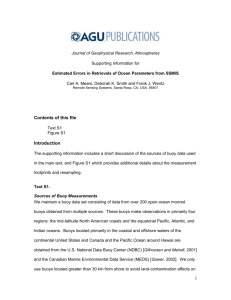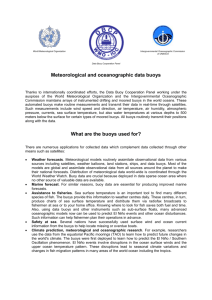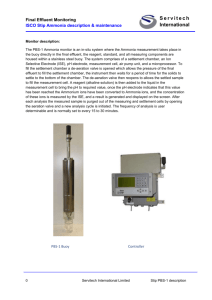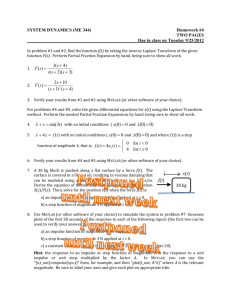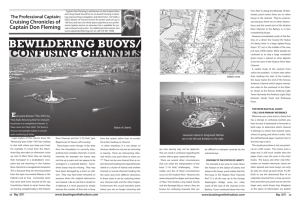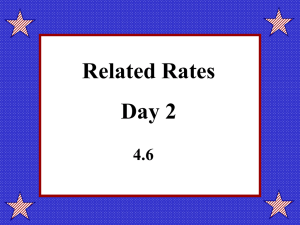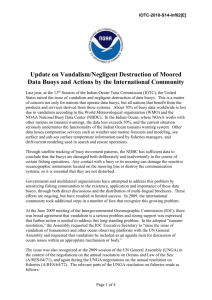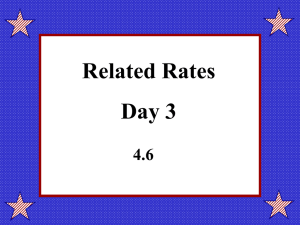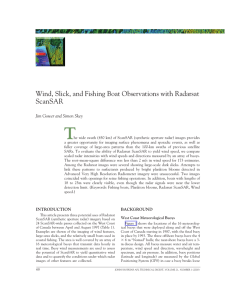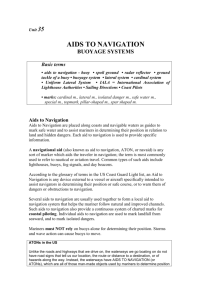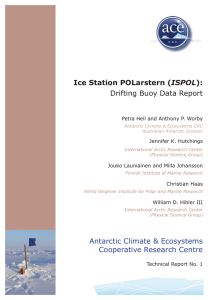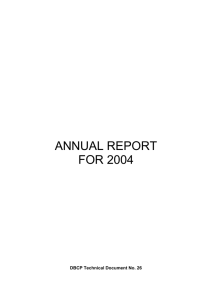The weak Hand as a Visible Referential Point For Time and Space
advertisement
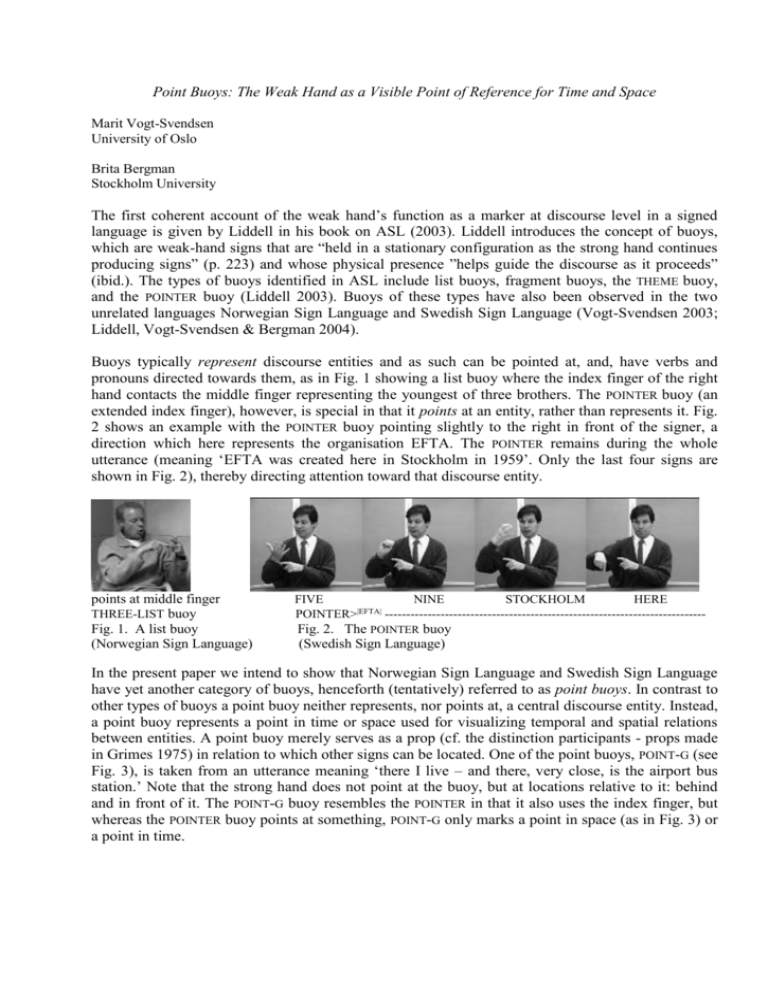
Point Buoys: The Weak Hand as a Visible Point of Reference for Time and Space Marit Vogt-Svendsen University of Oslo Brita Bergman Stockholm University The first coherent account of the weak hand’s function as a marker at discourse level in a signed language is given by Liddell in his book on ASL (2003). Liddell introduces the concept of buoys, which are weak-hand signs that are “held in a stationary configuration as the strong hand continues producing signs” (p. 223) and whose physical presence ”helps guide the discourse as it proceeds” (ibid.). The types of buoys identified in ASL include list buoys, fragment buoys, the THEME buoy, and the POINTER buoy (Liddell 2003). Buoys of these types have also been observed in the two unrelated languages Norwegian Sign Language and Swedish Sign Language (Vogt-Svendsen 2003; Liddell, Vogt-Svendsen & Bergman 2004). Buoys typically represent discourse entities and as such can be pointed at, and, have verbs and pronouns directed towards them, as in Fig. 1 showing a list buoy where the index finger of the right hand contacts the middle finger representing the youngest of three brothers. The POINTER buoy (an extended index finger), however, is special in that it points at an entity, rather than represents it. Fig. 2 shows an example with the POINTER buoy pointing slightly to the right in front of the signer, a direction which here represents the organisation EFTA. The POINTER remains during the whole utterance (meaning ‘EFTA was created here in Stockholm in 1959’. Only the last four signs are shown in Fig. 2), thereby directing attention toward that discourse entity. points at middle finger THREE-LIST buoy Fig. 1. A list buoy (Norwegian Sign Language) FIVE NINE STOCKHOLM HERE POINTER>|EFTA| --------------------------------------------------------------------------- Fig. 2. The POINTER buoy (Swedish Sign Language) In the present paper we intend to show that Norwegian Sign Language and Swedish Sign Language have yet another category of buoys, henceforth (tentatively) referred to as point buoys. In contrast to other types of buoys a point buoy neither represents, nor points at, a central discourse entity. Instead, a point buoy represents a point in time or space used for visualizing temporal and spatial relations between entities. A point buoy merely serves as a prop (cf. the distinction participants - props made in Grimes 1975) in relation to which other signs can be located. One of the point buoys, POINT-G (see Fig. 3), is taken from an utterance meaning ‘there I live – and there, very close, is the airport bus station.’ Note that the strong hand does not point at the buoy, but at locations relative to it: behind and in front of it. The POINT-G buoy resembles the POINTER in that it also uses the index finger, but whereas the POINTER buoy points at something, POINT-G only marks a point in space (as in Fig. 3) or a point in time. CLOSE-TO Fig. 3. An points points behind POINT-G in front of POINT-G POINT-G------------------------------example of the POINT-G buoy (Norwegian Sign Language) Some instances of point buoys may at first look similar to fragment buoys, i.e. buoys that consist of the weak hand remaining from a two-handed sign. However, a thorough analysis reveals that they function differently. Whereas a fragment buoy represents the entity referred to by the preceding sign, i.e. the sign it stems from, a point buoy does not. Put differently (in terms of Liddell’s model), a point buoy does not blend with a discourse entity to become a visible instance of that entity. A point buoy blends with a point of time and place and becomes a referential point, constituting a visible partition in signing space. Fig. 4 shows how the POINT-B buoy, stemming from JUST-BEFORE, is used as a referential marker for time separating ‘before’ and ‘after’. Both the pointing to the left of POINTB (’at that point in time’) and the starting point of the verb MOVE to the left of POINT-B refer to ‘before’, while the end point of MOVE to the right of POINT-B refers to ‘after’. Note that the end point of MOVE is also forward of POINT-B. The forward location does not refer to time, but to a place, Strømmen. POINT-B in Fig. 4 remains during the whole utterance meaning ’the decision was made just before they moved to Strømmen’. DECISION JUST-BEFORE points left of POINT-B MOVE left of POINT-B>right,forward POINT-B---------------------------------------------------------------- TO STRØMMEN ------------------------------------------------ Fig. 4. An example of the POINT-B buoy (Norwegian Sign Language) Using data from videotaped dialogues (Norwegian Sign Language) and monologues (Swedish Sign Language) we will argue along the lines indicated above, that point buoys, though sharing some properties with other types of buoys, do constitute a category of their own. This category turns out to be of crucial importance when talking about time and space. References Grimes, J. E. (1975): The thread of discourse. The Hague: Mouton. Liddell, S. K. (2003): Grammar, Gesture, and Meaning in American Sign Language. Cambridge: Cambridge University Press. Liddell, S. K., Vogt-Svendsen, M. & Bergman, B. (2004): Crosslinguistic Comparison of Buoys: Evidence from American, Norwegian and Swedish Sign Language. Paper presented at the 26. Jahrestagung der Deutsche gesellschaft für sprachenwissenschaf in Mainz am 25.27. February 2004. Manuscript. Vogt-Svendsen, M. (2003): “Buoys” – one role of the weak hand. Work in progress on Norwegian Sign Language. [Abstract and handout.] Presentation at Department of Language and Communication Sciences, City University London, 28.11.2003.

